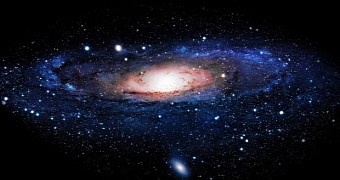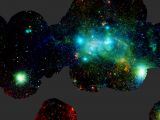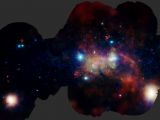A never-before-seen space image released by ESA scientists this Friday reveals the core anatomy of our home galaxy, the Milky Way. The image, which you'll find in the gallery below, was obtained with the help of the space agency's XMM-Newton X-ray observatory, launched back in December 1999 and named in honor of Sir Isaac Newton.
The orbiting observatory made it possible for astronomers to map dying stars and their effect on their surroundings, stellar clusters and even the black hole at the Milky Way's center. The portion of space revealed in the image sits about 27,000 light-years away. The image itself covers a region about 1,000 light-years across.
There's a lot of commotion going on
The bright splotches of light visible in this portrait of the center of the Milky Way produced by ESA's XMM-Newtown X-ray observatory show pairs of stars of which one reached the end of its life and transformed into a neutron star.
Neutron stars are the densest and smallest stars so far documented. They exert tremendous gravitational pulls and so, when they form as part of a binary system, they start feeding on the surviving companion.
“Because of their high densities, these compact remnants devour mass from their companion star, heating the material up and causing it to shine brightly in X-rays,” scientists say. They act on the surrounding gas in much the same manner.
Thus, both dying stars that have exploded into supernovae and the neutron stars they give rise to are known to produce powerful winds that shape the mammoth clouds of gas that populate the cosmos.
Then there are young stars and stellar clusters, revealed in this image in white and red. Like old, dying stars, young ones birth powerful winds too and, in doing so, alter their surroundings.
It's Sagittarius A* that steals the show
Like pretty much all other galaxies, the Milky Way has a black hole at its center. Its name is Sagittarius A* and, in this latest view of the core of our galaxy, its location is revealed by the bright, fuzzy blot to the right. Astronomers estimate its mass is a few million times that of the Sun.
Although black holes do not emit light, they act on their surroundings in that they draw in matter. Caught in a black hole's gravitational pull, matter emits light at different wavelengths, which scientists can track to learn more about the black hole's behavior.
The XMM-Newton X-ray observatory's view of Sagittarius A* reveals two lobes most likely made up of hot gas extending both above and below it. Of these two lobes, the one to the lower left of the black hole is shaped like a crescent.
These days, Sagittarius A* is quite tame. Nonetheless, scientists suspect that, when it was younger, it had a somewhat heartier appetite and devoured matter at a faster pace than it now does.

 14 DAY TRIAL //
14 DAY TRIAL // 


